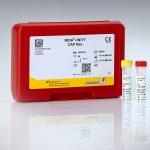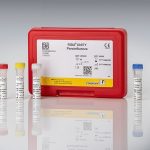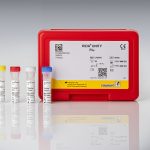Intended use:
For in vitro diagnostic use. The RIDA®UNITY CAP Bac Test, performed automatically or manually, is a multiplex real-time PCR for the direct qualitative detection and differentiation of:
– Chlamydophila pneumoniae DNA
– Legionella pneumophila DNA
– Mycoplasma pneumoniae DNA
in human bronchoalveolar lavage (BAL) or nasal/throat swabs from individuals with signs and symptoms of community-acquired pneumonia (CAP).
The RIDA®UNITY CAP Bac Test is intended to support the differential diagnosis of infection with Chlamydophila pneumoniae, Legionella pneumophila, and Mycoplasma pneumoniae in patients with symptoms of community-acquired pneumonia in conjunction with other clinical and laboratory findings.
Negative results do not rule out infection with Chlamydophila pneumoniae, Legionella pneumophila, and Mycoplasma pneumoniae and should not be used as the sole basis for diagnosis.
The product is intended for professional use.
General information:
Community-acquired pneumonia (CAP) is the most frequently recorded infectious disease worldwide and is the infectious disease that frequently leads to death in Western nations. Bacteria are the most frequent pathogens of CAP, and a distinction is drawn between typical and atypical pathogens. Atypical CAP bacteria are difficult to detect because they cannot be determined using standard methods such as regular sputum or blood culture or gram staining. The most common atypical CAP bacteria include Mycoplasma pneumoniae (M. pneumoniae), Legionella pneumophila (L. pneumophila), and Chlamydophila pneumoniae (C. pneumoniae)
Up to 20 % of community-acquired pneumonias are caused by M. pneumoniae.
M. pneumoniae is a cell wall-less, aerobic bacterium that is primarily transmitted aerogenically from person to person via droplets. In most cases, infection with M. pneumoniae causes tracheobronchitis, and pneumonia requiring antibiotic treatment develops in 5 – 10 % of M. pneumoniae infections. However, pneumonia with M. pneumoniae is also associated with superinfections in all age groups. As cultivation is extremely complex, diagnosis is carried out using RT-PCR. For this test, it is important that the sample material contains sufficient pathogens. Therefore, bronchial secretions (BAL) are recommended, and only in exceptional cases, e.g., in children, deeply aspirated nasal secretions can be used.
Chlamydophila pneumoniae is a gram-negative bacterium and is transmitted aerogenically, sometimes beyond the symptomatic phase. Infection with C. pneumoniae is generally difficult to overcome, but mild. It is estimated that C. pneumoniae has an infection rate of 50 – 70 %, and 60 % of the population will have experienced C. pneumoniae infection by the age of 20 years. A severe case can lead to atypical pneumonia. In Germany, it is estimated that up to 5 % of CAPs are caused by C. pneumoniae. The focus of laboratory diagnosis in cases of infection is on molecular biological DNA detection using PCR from bronchial secretions (BAL) as other methods, such as bacteriologic culture, are extremely time-consuming and complicated.
Legionella pneumophila belongs to the family Legionellaceae, and this family is divided into over 40 species with more than 70 serogroups. Legionella bacteria are facultative intracellular gram-negative bacteria whose peak infection rate occurs in summer and early fall. With Legionnaires’ disease, a differentiation is made between community-acquired, travel-related, and nosocomial infections. In the USA, the mortality rate of nosocomial infections is between 15 % and 20 %. In Europe, 12 % of all Legionella infections are fatal. Most Legionella species are to be considered potentially pathogenic to humans. Infection occurs via aerosol containing water. Human-to-human transmission has not been described. Legionella pneumophila strains of serogroup 1 play a special role in transmission as they also lead to severe pneumonia in immunocompetent people. An infection with Legionella pneumophila mainly leads to Legionnaires’ disease with the full picture of pneumonia, but also to Pontiac fever with more flu-like symptoms. Due to the proliferation of the pathogens in the alveolar macrophages, invasive sampling (usually BAL) is recommended. The method of choice here, due to its fast and effective results, is also molecular biological detection using PCR.
Image Gallery
Accessories:
| Art. No. | UN2705 |
|---|---|
| Test format | real-time PCR with 96 reactions |
Dear customers,
we have started to provide the documents for our products in an electronic format. These are the Instructions for Use (IFU), the Safety Data Sheets (SDS) and the Certificate of Analysis (CoA). For batches placed on the market after 01 January 2023, you can find our documents on the eIFU portal eifu.r-biopharm.com/clinic.












